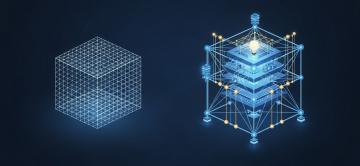RAG vs. Fine-Tuning: A CTO's Cost-Effective Guide

RAG vs. Fine-Tuning: A CTO's Framework for Making the Most Cost-Effective Choice
As a technology leader, you are constantly evaluating how to integrate Large Language Models (LLMs) to create a competitive advantage. The conversation quickly moves beyond "if" to "how," and two terms dominate the technical strategy: Retrieval-Augmented Generation (RAG) and Fine-Tuning. Often presented as competing methodologies, the choice between them is one of the most significant architectural and financial decisions you will make in your AI journey.
Making the wrong choice can lead to runaway costs, unmanageable data pipelines, and models that fail to meet business requirements. This isn't just a technical debate for your engineering team; it's a strategic decision with direct P&L impact. This article provides a clear framework for CTOs and technology leaders to navigate this choice, focusing not on the hype, but on the practical considerations of cost, scalability, and maintainability.
Understanding the Core Functions: An Open-Book vs. a Closed-Book Exam
Before we build the framework, let's demystify the two approaches with a simple analogy.
- RAG is the "Open-Book Exam": The LLM is a brilliant, general-purpose reasoner. RAG gives this reasoner access to a specific, up-to-date textbook (your proprietary data in a vector database). When asked a question, it first looks up the relevant passages in the book and then uses its reasoning ability to synthesize an answer based on that retrieved context. Its primary function is knowledge retrieval.
- Fine-Tuning is "Specialized Job Training": This process takes a general-purpose LLM and retrains a portion of it on a curated dataset of examples. It doesn't primarily teach the model new facts; it teaches it a new *skill*, *style*, *tone*, or how to follow a specific output *format*. After training, the model's inherent behavior is altered. Its primary function is skill/behavior adaptation.
Expert Insight: They Are Not Mutually Exclusive
The most advanced AI systems often use a hybrid approach. For example, a financial services company might fine-tune a model to understand complex financial jargon and adopt the formal communication style of an analyst. This fine-tuned model is then used in a RAG system to answer questions about real-time market data. This combines the best of both worlds: specialized skill and fresh, verifiable knowledge.
The CTO's Decision Framework
To make a cost-effective and technically sound decision, evaluate your project against these five critical axes. A clear winner will often emerge when you map your business needs to this framework.
Diagram 1: A decision flowchart for choosing between RAG and Fine-Tuning.
RAG vs. Fine-Tuning: A Comparative Analysis
This table provides a direct comparison across key business and technical dimensions.
| Dimension | Retrieval-Augmented Generation (RAG) | Fine-Tuning |
|---|---|---|
| Primary Use Case | Answering questions over private or dynamic documents. Reducing hallucinations with factual data. | Altering model style, tone, or format. Teaching complex, domain-specific language nuances. |
| Cost Profile | Lower upfront compute cost. Ongoing costs for vector database, data ingestion, and inference. | High upfront compute and data curation cost. Can have lower per-inference cost if using a smaller, specialized model. |
| Data Freshness | Excellent. Knowledge can be updated in near real-time by simply updating the vector database. | Poor. The model is a static snapshot. Incorporating new knowledge requires a full re-training cycle. |
| Implementation Complexity | Lower initial barrier. Complexity lies in the data engineering pipeline (ETL, chunking, embedding). | Higher. Requires deep ML expertise, significant data curation, and managing training infrastructure. |
| Explainability & Traceability | High. You can inspect the retrieved context to see exactly what information the LLM used for its answer. | Low. It's a "black box." You cannot easily trace why the model produced a specific output. |
| Hallucination Risk | Lower. Grounded in provided context, but can still misinterpret or over-extrapolate from it. | Higher for facts not in training data. It has no external reference and may "confidently" invent information. |
Key Questions to Ask Your Team
Use this checklist during your next project planning session to guide the discussion towards a clear decision.
- What is the single most important outcome: adapting the model's behavior or grounding it in our knowledge?
- How often will the underlying data for this system change? Daily? Weekly? Annually?
- What is our budget allocation for upfront ML training compute versus ongoing data infrastructure?
- Do our compliance or operational requirements demand that we can trace the source of every answer?
- Do we have the in-house MLOps expertise to manage a complex fine-tuning and re-deployment pipeline?
Conclusion: The Right Tool for the Right Job
The RAG vs. Fine-Tuning debate is not about a superior technology, but about aligning the right tool with the right business problem. For the vast majority of enterprise use cases centered on leveraging proprietary knowledge, RAG is the more cost-effective, scalable, and manageable starting point. Its traceability and ability to handle dynamic data are critical for production systems. Fine-tuning is a powerful, but more specialized and costly, tool best reserved for adapting the core behavior of a model when prompt engineering and RAG fall short.
Making this decision correctly requires a partner who understands both the nuances of advanced AI and the realities of building scalable data platforms. At ActiveWizards, we specialize in architecting these systems, ensuring your AI investment is not only powerful but also practical and profitable.
Architect Your AI Strategy with ActiveWizards
Choosing between RAG and Fine-Tuning is a foundational architectural decision. Get it right with a partner who has deep expertise in building and deploying enterprise-grade intelligent systems. We help you design the most cost-effective and performant solution for your specific business needs.



Comments (0)
Add a new comment: